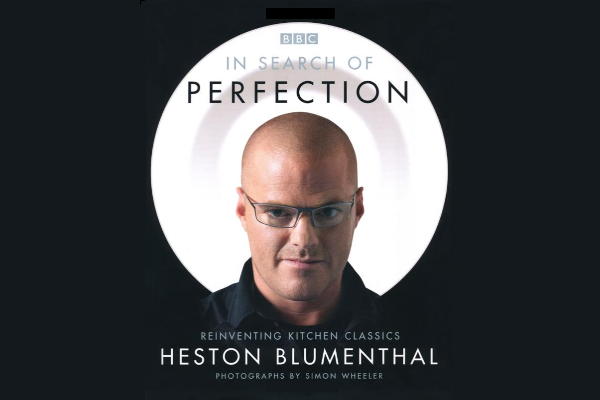This is not a new book (it was published in 2006). However, Mr Not Delia found it on a bargain bookshelf and brought it home because it looked interesting. With a hefty original cover price of £30, I should jolly well hope so.
For those who have been on Mars for the last couple of decades and are unfamiliar with the name,
Heston Blumenthal is the most progressive chef of his generation. In 2004 he won the coveted three Michelin stars in near-record time for his restaurant The Fat Duck, which was voted the Best Restaurant in the World in 2005 by an international panel of 500 experts.
(From the blurb on the dust cover)
It was indeed an interesting book: Heston Blumenthal examines eight British favourites and tries to find out what makes them so great. In his search for perfection, he interviews experts, conducts his own experiments, and explores the origins of each dish. The text is seasoned with cooking tips and ideas – and some rather bizarre suggestions (including a culinary use of a vacuum cleaner).
Whilst the book was entertaining, most of the quest for perfection is wildly impractical even for confident and experienced cooks. In addition to the lengthy preparation and cooking times for most of the dishes, many of the ingredients were difficult to source and even then, not practical for a home cook.
Coldness is, of course, also the key to the ice cream. I’d had problems with domestic ice-cream makers because they didn’t get the mixture cold enough. The stuff I used at Waltham Place Farm – liquid nitrogen – was one solution, but it’s difficult to obtain and difficult to work with. I seemed to be stuck between a rock and a hard place – and then I remembered dry ice. At -80°C it would freeze the mixture properly without causing havoc in the kitchen. And, as the main source of eerie mist effects on stage and screen, it would be easier to obtain than a canister of liquid nitrogen.
(Treacle tart and ice cream, p 294)
Hmm, it’s a bit of an understatement to say that liquid nitrogen is difficult to work with. Does anyone remember the story of the young German chef who blew his hands off by trying to emulate Blumenthal’s style of cooking at home? I blogged about it back in 2009 – Don’t try this at home!
It’s true to say that dry ice is easier to obtain, but the problem with that solution is that dry ice is usually sold in industrial quantities and must be used on the day of delivery – so there’s not much chance of practising. Additionally it’s not cheap! The smallest quantity I could find was £27.60 for a 2.5 kg bag. Besides, at -80°C, common sense suggests there would be dangers inherent in working with such a product. I think I’ll just give this one a miss.
And there were similar stumbling blocks on several of the recipes to prevent even the keenest home cook from wanting to have a go.
As well as difficult to source ingredients some of the recipes required fairly specialised equipment. As a bit of a gadget freak, I admit to having some of them but certainly not all. And even good cheffy kit didn’t make the grade sometimes.
Special equipment [required]: …blowtorch (the heavy-duty kind from a DIY store: a crème brûlée special won’t do the job quickly enough)
(Steak, p 166)
Also, the “science” in the book was questionable. The “experiments” seemed less than rigorous. For example, in the selection of potatoes to make the best chips he undertook a considerable amount of research and testing but when the crunch came it was as though he just plumped for a potato that would suffice rather than the perfect one he sought. (Maris Piper, in case you were wondering).
I also wasn’t particularly keen on the photographs, although they were of excellent quality. I like a bit of food porn to drool over or something instructive. These were neither. They consisted mostly of uncaptioned photos of Blumenthal doing various things. I’m not sure what in every case.
Despite these drawbacks – for someone hoping to try at new things at home and bring their cooking up a notch – the book is inspiring and you can probably pick up a few tips to improve your skills. And the background information on food history and provenance is quite fascinating and might make you think more deeply about what you’re eating. You might not aim for perfection in the same way as Blumenthal, but you’re likely to feel encouraged to try harder to produce dishes of a higher quality.
In conclusion, this is worth buying if you’re a fan of Heston Blumenthal, but for the vast majority of home cooks this book is likely to entertain and inspire rather than provide much practical help to improve your cooking. I suspect it’s extremely unlikely that many home cooks would actually attempt the recipes. And the bottom line is: for thirty quid, there are books I’d rather have.
In Search of Perfection: Reinventing Kitchen Classics by Heston Blumenthal
Hardback, 320 pages
2006, Bloomsbury
ISBN 9781408849422
RRP: £30.00

Leave a Reply
You must be logged in to post a comment.